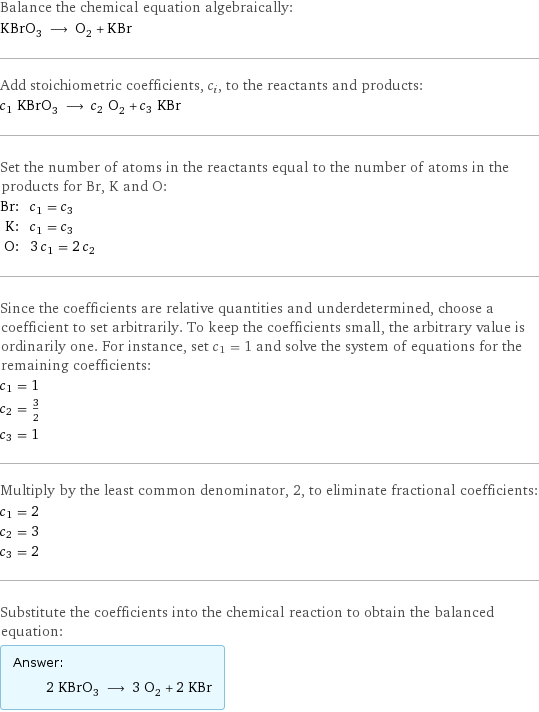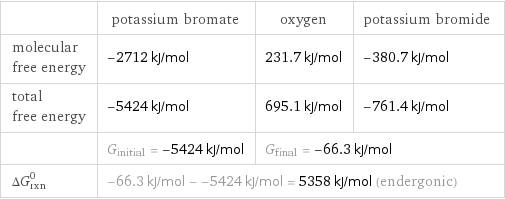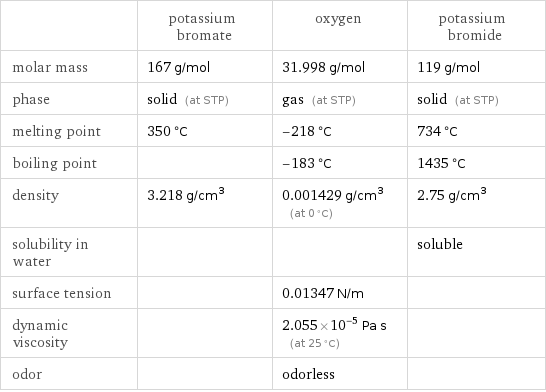Input interpretation

KBrO_3 potassium bromate ⟶ O_2 oxygen + KBr potassium bromide
Balanced equation

Balance the chemical equation algebraically: KBrO_3 ⟶ O_2 + KBr Add stoichiometric coefficients, c_i, to the reactants and products: c_1 KBrO_3 ⟶ c_2 O_2 + c_3 KBr Set the number of atoms in the reactants equal to the number of atoms in the products for Br, K and O: Br: | c_1 = c_3 K: | c_1 = c_3 O: | 3 c_1 = 2 c_2 Since the coefficients are relative quantities and underdetermined, choose a coefficient to set arbitrarily. To keep the coefficients small, the arbitrary value is ordinarily one. For instance, set c_1 = 1 and solve the system of equations for the remaining coefficients: c_1 = 1 c_2 = 3/2 c_3 = 1 Multiply by the least common denominator, 2, to eliminate fractional coefficients: c_1 = 2 c_2 = 3 c_3 = 2 Substitute the coefficients into the chemical reaction to obtain the balanced equation: Answer: | | 2 KBrO_3 ⟶ 3 O_2 + 2 KBr
Structures

⟶ +
Names

potassium bromate ⟶ oxygen + potassium bromide
Reaction thermodynamics
Enthalpy

| potassium bromate | oxygen | potassium bromide molecular enthalpy | -360.2 kJ/mol | 0 kJ/mol | -393.8 kJ/mol total enthalpy | -720.4 kJ/mol | 0 kJ/mol | -787.6 kJ/mol | H_initial = -720.4 kJ/mol | H_final = -787.6 kJ/mol | ΔH_rxn^0 | -787.6 kJ/mol - -720.4 kJ/mol = -67.2 kJ/mol (exothermic) | |
Gibbs free energy

| potassium bromate | oxygen | potassium bromide molecular free energy | -2712 kJ/mol | 231.7 kJ/mol | -380.7 kJ/mol total free energy | -5424 kJ/mol | 695.1 kJ/mol | -761.4 kJ/mol | G_initial = -5424 kJ/mol | G_final = -66.3 kJ/mol | ΔG_rxn^0 | -66.3 kJ/mol - -5424 kJ/mol = 5358 kJ/mol (endergonic) | |
Equilibrium constant
![Construct the equilibrium constant, K, expression for: KBrO_3 ⟶ O_2 + KBr Plan: • Balance the chemical equation. • Determine the stoichiometric numbers. • Assemble the activity expression for each chemical species. • Use the activity expressions to build the equilibrium constant expression. Write the balanced chemical equation: 2 KBrO_3 ⟶ 3 O_2 + 2 KBr Assign stoichiometric numbers, ν_i, using the stoichiometric coefficients, c_i, from the balanced chemical equation in the following manner: ν_i = -c_i for reactants and ν_i = c_i for products: chemical species | c_i | ν_i KBrO_3 | 2 | -2 O_2 | 3 | 3 KBr | 2 | 2 Assemble the activity expressions accounting for the state of matter and ν_i: chemical species | c_i | ν_i | activity expression KBrO_3 | 2 | -2 | ([KBrO3])^(-2) O_2 | 3 | 3 | ([O2])^3 KBr | 2 | 2 | ([KBr])^2 The equilibrium constant symbol in the concentration basis is: K_c Mulitply the activity expressions to arrive at the K_c expression: Answer: | | K_c = ([KBrO3])^(-2) ([O2])^3 ([KBr])^2 = (([O2])^3 ([KBr])^2)/([KBrO3])^2](../image_source/e22e00161adfe635722fe36eb6d33293.png)
Construct the equilibrium constant, K, expression for: KBrO_3 ⟶ O_2 + KBr Plan: • Balance the chemical equation. • Determine the stoichiometric numbers. • Assemble the activity expression for each chemical species. • Use the activity expressions to build the equilibrium constant expression. Write the balanced chemical equation: 2 KBrO_3 ⟶ 3 O_2 + 2 KBr Assign stoichiometric numbers, ν_i, using the stoichiometric coefficients, c_i, from the balanced chemical equation in the following manner: ν_i = -c_i for reactants and ν_i = c_i for products: chemical species | c_i | ν_i KBrO_3 | 2 | -2 O_2 | 3 | 3 KBr | 2 | 2 Assemble the activity expressions accounting for the state of matter and ν_i: chemical species | c_i | ν_i | activity expression KBrO_3 | 2 | -2 | ([KBrO3])^(-2) O_2 | 3 | 3 | ([O2])^3 KBr | 2 | 2 | ([KBr])^2 The equilibrium constant symbol in the concentration basis is: K_c Mulitply the activity expressions to arrive at the K_c expression: Answer: | | K_c = ([KBrO3])^(-2) ([O2])^3 ([KBr])^2 = (([O2])^3 ([KBr])^2)/([KBrO3])^2
Rate of reaction
![Construct the rate of reaction expression for: KBrO_3 ⟶ O_2 + KBr Plan: • Balance the chemical equation. • Determine the stoichiometric numbers. • Assemble the rate term for each chemical species. • Write the rate of reaction expression. Write the balanced chemical equation: 2 KBrO_3 ⟶ 3 O_2 + 2 KBr Assign stoichiometric numbers, ν_i, using the stoichiometric coefficients, c_i, from the balanced chemical equation in the following manner: ν_i = -c_i for reactants and ν_i = c_i for products: chemical species | c_i | ν_i KBrO_3 | 2 | -2 O_2 | 3 | 3 KBr | 2 | 2 The rate term for each chemical species, B_i, is 1/ν_i(Δ[B_i])/(Δt) where [B_i] is the amount concentration and t is time: chemical species | c_i | ν_i | rate term KBrO_3 | 2 | -2 | -1/2 (Δ[KBrO3])/(Δt) O_2 | 3 | 3 | 1/3 (Δ[O2])/(Δt) KBr | 2 | 2 | 1/2 (Δ[KBr])/(Δt) (for infinitesimal rate of change, replace Δ with d) Set the rate terms equal to each other to arrive at the rate expression: Answer: | | rate = -1/2 (Δ[KBrO3])/(Δt) = 1/3 (Δ[O2])/(Δt) = 1/2 (Δ[KBr])/(Δt) (assuming constant volume and no accumulation of intermediates or side products)](../image_source/cce40bfc0d884464cc093f009299b00f.png)
Construct the rate of reaction expression for: KBrO_3 ⟶ O_2 + KBr Plan: • Balance the chemical equation. • Determine the stoichiometric numbers. • Assemble the rate term for each chemical species. • Write the rate of reaction expression. Write the balanced chemical equation: 2 KBrO_3 ⟶ 3 O_2 + 2 KBr Assign stoichiometric numbers, ν_i, using the stoichiometric coefficients, c_i, from the balanced chemical equation in the following manner: ν_i = -c_i for reactants and ν_i = c_i for products: chemical species | c_i | ν_i KBrO_3 | 2 | -2 O_2 | 3 | 3 KBr | 2 | 2 The rate term for each chemical species, B_i, is 1/ν_i(Δ[B_i])/(Δt) where [B_i] is the amount concentration and t is time: chemical species | c_i | ν_i | rate term KBrO_3 | 2 | -2 | -1/2 (Δ[KBrO3])/(Δt) O_2 | 3 | 3 | 1/3 (Δ[O2])/(Δt) KBr | 2 | 2 | 1/2 (Δ[KBr])/(Δt) (for infinitesimal rate of change, replace Δ with d) Set the rate terms equal to each other to arrive at the rate expression: Answer: | | rate = -1/2 (Δ[KBrO3])/(Δt) = 1/3 (Δ[O2])/(Δt) = 1/2 (Δ[KBr])/(Δt) (assuming constant volume and no accumulation of intermediates or side products)
Chemical names and formulas

| potassium bromate | oxygen | potassium bromide formula | KBrO_3 | O_2 | KBr Hill formula | BrKO_3 | O_2 | BrK name | potassium bromate | oxygen | potassium bromide IUPAC name | potassium bromate | molecular oxygen | potassium bromide
Substance properties

| potassium bromate | oxygen | potassium bromide molar mass | 167 g/mol | 31.998 g/mol | 119 g/mol phase | solid (at STP) | gas (at STP) | solid (at STP) melting point | 350 °C | -218 °C | 734 °C boiling point | | -183 °C | 1435 °C density | 3.218 g/cm^3 | 0.001429 g/cm^3 (at 0 °C) | 2.75 g/cm^3 solubility in water | | | soluble surface tension | | 0.01347 N/m | dynamic viscosity | | 2.055×10^-5 Pa s (at 25 °C) | odor | | odorless |
Units
